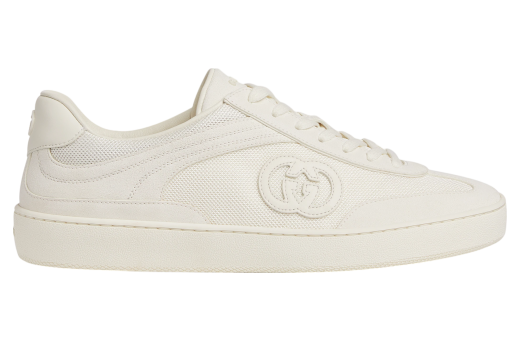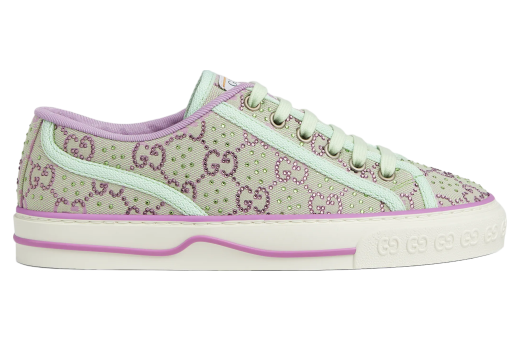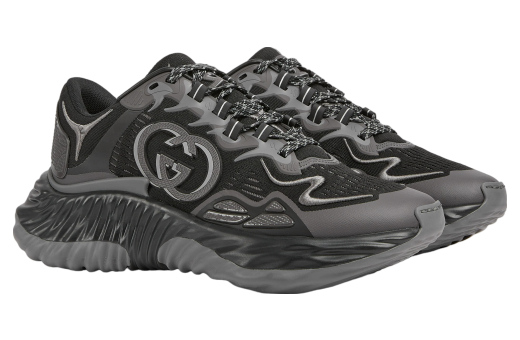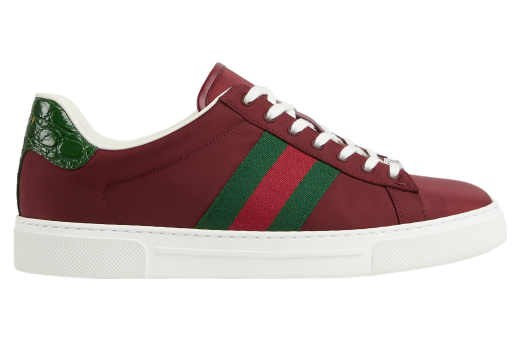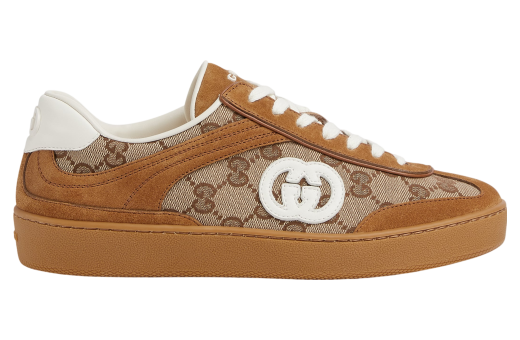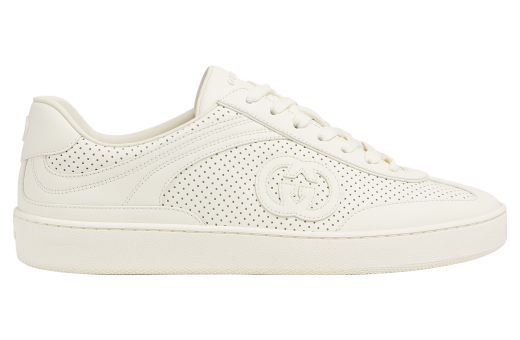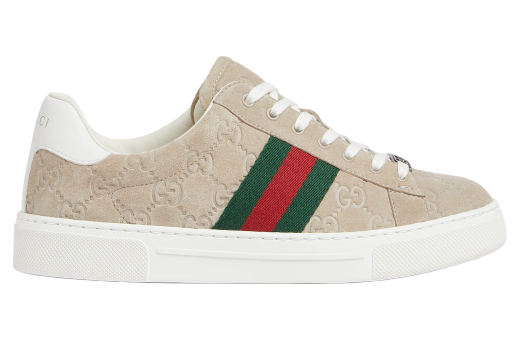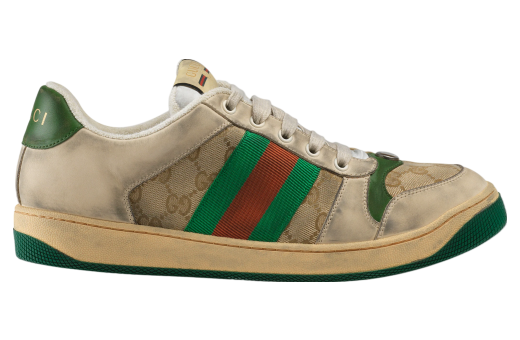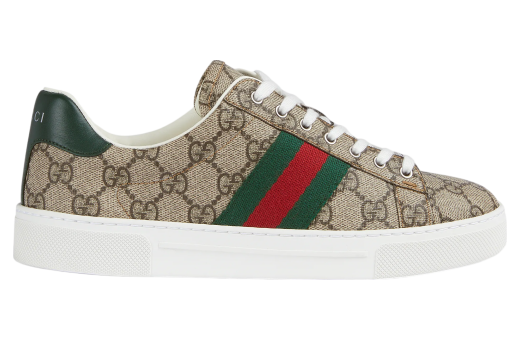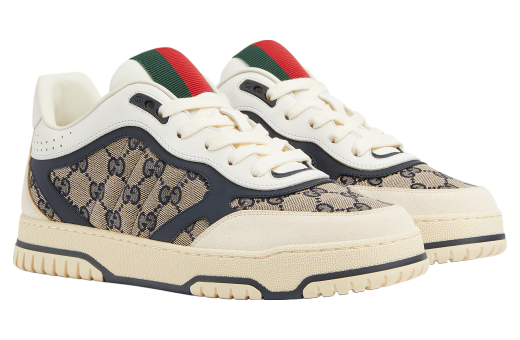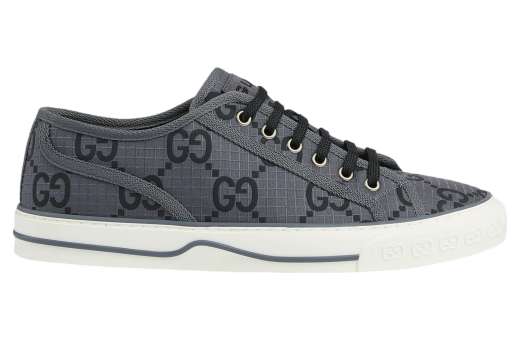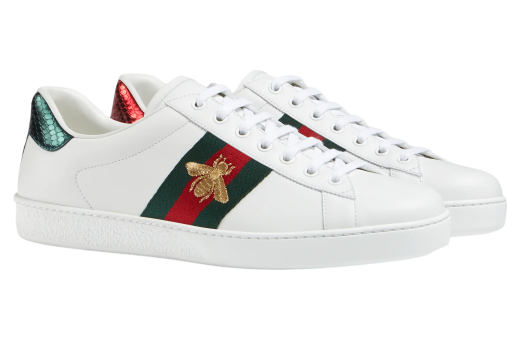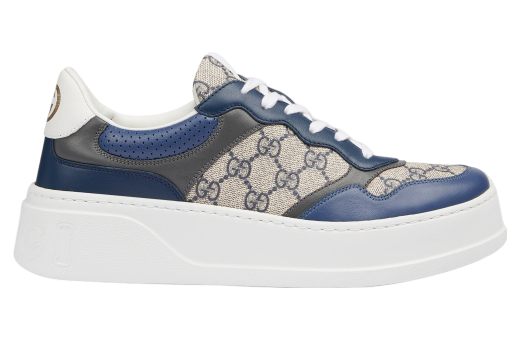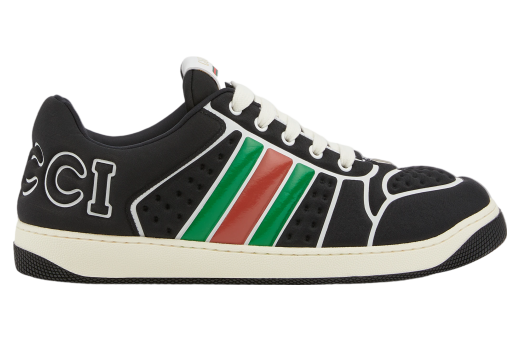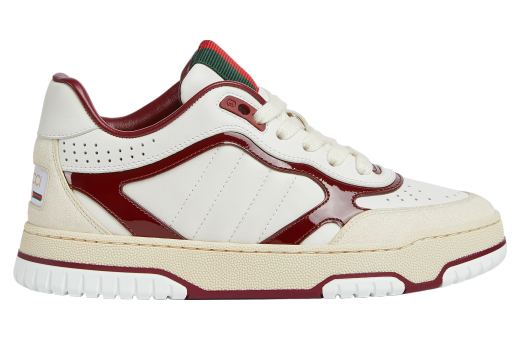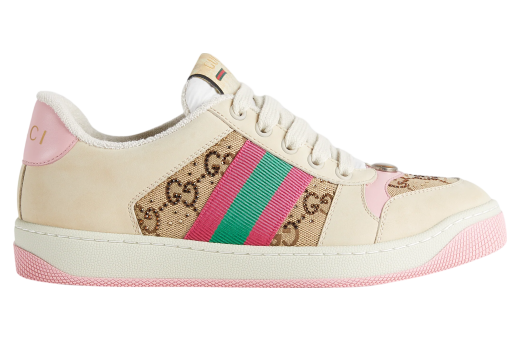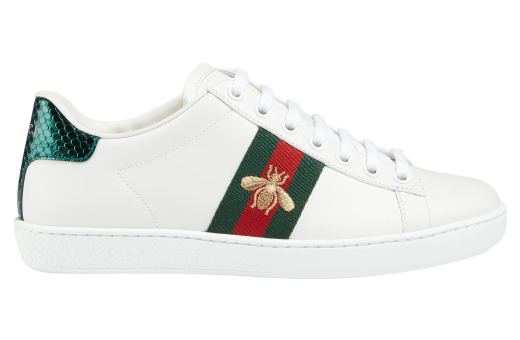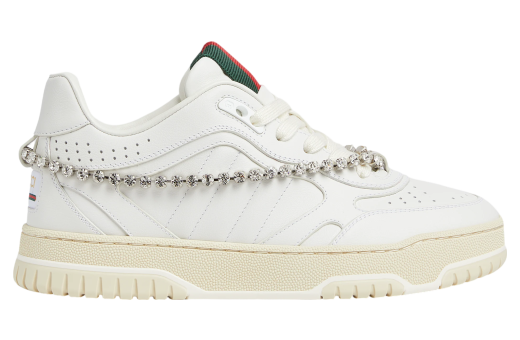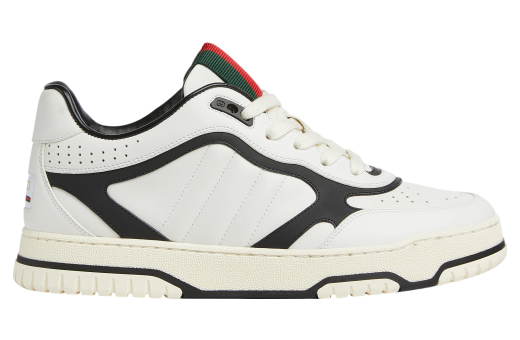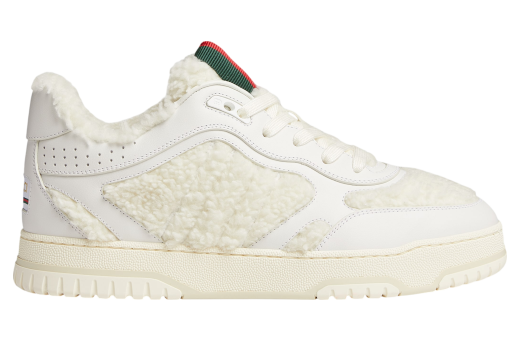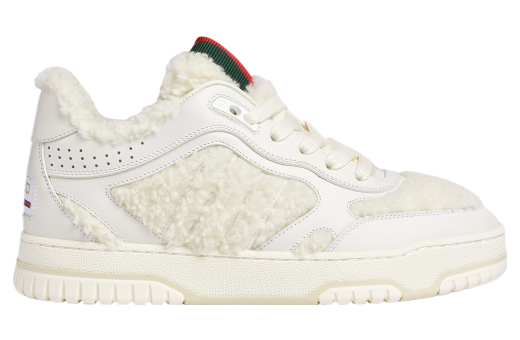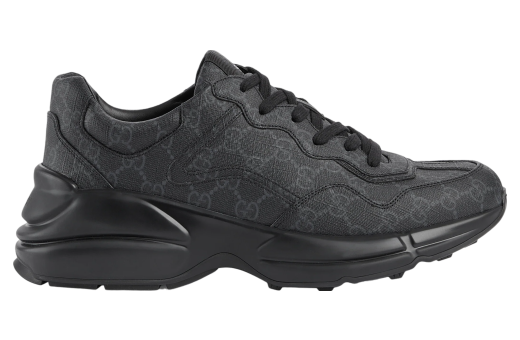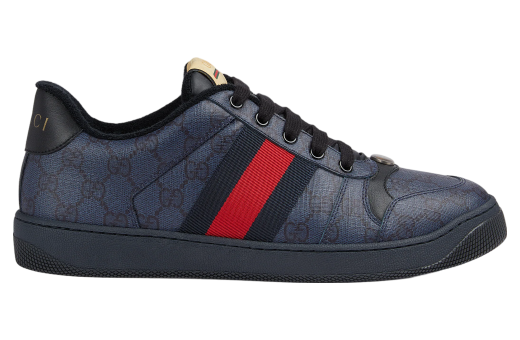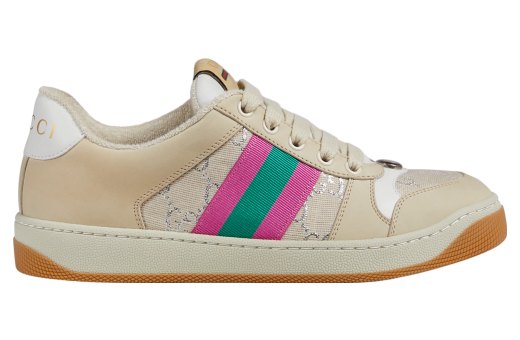Gucci
Gucci sneakers have solidified their status as a cornerstone of luxury streetwear, merging high fashion with casual footwear. Opulent materials like premium leather, suede, and even exotic skins are commonplace, resulting in shoes that not only boast extraordinary comfort but also meticulous craftsmanship. Signature design elements such as the brand’s iconic GG logo, the red and green webbing, and intricate embroidery or appliqués make each pair unmistakably Gucci. Whether it’s the bold aesthetic of the Gucci Rhyton sneakers or the suave minimalism of the Ace series, these shoes cater to a wide array of fashion sensibilities, ensuring that they remain a coveted addition to any wardrobe.
In addition to their distinctive style and premium quality, Gucci sneakers have captured the zeitgeist by successfully blending contemporary trends with timeless design principles. Their innovative collections often feature playful motifs and artistic collaborations, pushing the boundaries of what luxury sneakers can represent. Season after season, Gucci manages to remain relevant by tapping into cultural currents and pivoting swiftly to embrace sustainable practices, addressing the growing consumer demand for eco-friendly fashion. The brand’s commitment to both preserving its storied heritage and exploring new avenues of creativity helps solidify Gucci sneakers' deserved place at the pinnacle of high-end fashion.
History of Gucci
The Rich History of Gucci: A Fashion Legacy
Gucci, the epitome of Italian luxury and sophistication, has traversed almost a century of evolving fashion trends, crises, and cultural shifts. The brand's journey from a modest leather goods store in Florence to an internationally renowned symbol of opulence tells a captivating story of innovation, resilience, and transformation. This history embarks in the early 20th century and spans generations of a family renowned for its ambitious vision and often tumultuous relationships.
The Genesis
In 1921, Guccio Gucci founded the House of Gucci in Florence, Italy. Born in 1881, Guccio was the son of an Italian merchant and spent his formative years in London and Paris working at upscale hotels. It was from his time working as a liftboy at the Savoy Hotel in London that Guccio became enamored with the sophisticated elegance of the British elite, particularly their refined luggage. This exposure, coupled with his inherent love for luxury goods, inspired him to start his own leather goods company upon returning to Italy.
Guccio began by creating high-quality luggage, leather accessories, and equestrian gear. His keen eye for craftsmanship and design quickly garnered attention. The interlocking GG logo, which would become synonymous with the brand, was respectfully introduced as a tribute to Guccio Gucci himself. By the 1930s, the store in Via della Vigna Nuova was flourishing, attracting an affluent clientele.
Expansion and Innovation
During the 1930s and 1940s, under the dire economic strain of World War II, Gucci demonstrated remarkable innovation. With the scarcity of leather, the brand experimented with alternative materials. The creation of the bamboo-handled bag in 1947 is one of Gucci's most celebrated innovations from this period. Bamboo, which was easily accessible due to import restrictions, was molded and heated, creating a unique handle that would become a lasting icon.
Post-World War II, Gucci fully embraced the concept of luxury. The infusion of creative designs and superior craftsmanship continued to linger. With its maroon, green, and beige stripes evoking luxury horse-riding paraphernalia and incorporating natural motifs, Gucci's designs resonated with a growing global market. During the 1950s, Guccio’s sons, Aldo, Vasco, Ugo, and Rodolfo, ushered the brand into international prominence, opening stores in Milan, New York, and later London, Paris, and Tokyo.
The Golden Era
The 1960s can be aptly described as Gucci’s golden era. Hollywood embraced Gucci's unique blend of sophistication and innovation. A-list celebrities like Elizabeth Taylor, Audrey Hepburn, Grace Kelly, and Jacqueline Kennedy were frequently seen adorned with Gucci accessories, further cementing the brand's place in the fashion elite. In particular, Jackie Kennedy’s fondness for the Gucci bag (later named the Jackie O) elevated the brand's allure.
During this period, the iconic double-G logo was introduced, the Flora scarf was designed for Princess Grace of Monaco by illustrator Vittorio Accornero, and the loafers with the distinctive horsebit detail became a symbol of wealth and refinement. The GG canvas quickly became an epitome of status, and Gucci’s reputation soared across continents.
Internal Strife and Challenges
Gucci’s history is not without its share of intrigue and conflict. The 1970s and 1980s saw the Gucci family embroiled in intense infighting. Aldo Gucci, who had taken a leading role in the company following Guccio’s death in 1953, faced challenges from within his own family. The sons battled for control, leading to legal disputes and public scandals.
The internal discord reached a climax in 1983 when Aldo was convicted of tax evasion and imprisoned. That same year, Rodolfo Gucci died, leaving his son, Maurizio Gucci, to inherit his shares. Maurizio’s leadership saw a period of turbulence marked by ruthless confrontations with his uncle Aldo and cousins, deteriorating the family’s grip on the brand. Amid these internal battles, the firm's creative direction floundered, and its once-stellar reputation began to tarnish.
Gucci was further hit by a series of economic missteps and widespread counterfeiting, which diluted the brand’s exclusivity. The fiscal woes culminated in Maurizio's decision to sell his remaining shares in 1993 to Investcorp, an investment company thereby ending the family’s direct involvement in the company.
Revival and Renaissance
With the brand’s legacy in jeopardy, Domenico De Sole and Tom Ford emerged as pivotal figures in Gucci's resurgence. Hired as an in-house designer in 1990, Tom Ford was promoted to Creative Director by De Sole, who became CEO in 1994. Ford injected provocative glamor back into Gucci, his daring vision a stark contrast to the sluggish creativity that marked the previous decade. The 1995 Fall/Winter collection marked a significant turning point, with Ford’s designs instantly captivating the fashion world.
Ford's sleek and sensual designs, combined with De Sole’s strategic business acumen, revived Gucci’s fortunes. The 1990s saw Gucci re-emerge as the epitome of modern luxury. Iconic pieces like the velvet hip-huggers, satin shirts, and bold advertisements featuring supermodels ignited global demand. Tom Ford redefined 'sexiness' for the brand, intertwining it seamlessly with sophistication, making Gucci the go-to label for high fashion.
By the late 1990s, Gucci was a fashion powerhouse. Ford and De Sole’s leadership extended beyond the brand, resulting in the creation of the Gucci Group, a luxury conglomerate. The association bolstered Gucci's economic stance by acquiring and partnering with brands like Yves Saint Laurent, Balenciaga, and Bottega Veneta.
Modern Era and Continued Innovation
In 2004, both Tom Ford and Domenico De Sole departed from Gucci, leading to an era characterized by several changes in leadership and creative direction. Frida Giannini, who took over as Creative Director, emphasized Gucci’s storied heritage while adding her touch of Italian romanticism. Under her leadership from 2006 to 2014, she upheld the brand’s luxurious appeal, particularly through equestrian themes and floral prints.
With Giannini's departure, 2015 marked the entry of Alessandro Michele as the new Creative Director. Michele, previously an accessory designer for the brand, revolutionized Gucci with his eclectic and whimsical aesthetic. Infusing retro glamor, maximalism, and a touch of androgyny, Michele's designs heralded a new era of creativity. Gucci’s collections became vivid, mixing pop culture, historical references, and audacious colors.
Michele's unique vision resonated deeply with contemporary audiences, propelling Gucci to new heights of popularity and profitability. His designs sparked a global craze, resonating particularly with millennials and the Gen-Z demographic. Moves towards sustainability and ethical fashion also marked Michele's tenure, as Gucci adopted eco-friendly practices and diversified its offerings.
Gucci Today: A Blend of Tradition and Modernity
In contemporary times, Gucci continues to navigate the dynamic landscape of fashion with a melding of tradition and modernity. The brand remains a pillar under the Kering Group, the luxury giant that acquired the Gucci Group, ensuring sustained growth and international acclaim. Michele's collections remain headline events in the fashion calendar, and the resolve to push creative boundaries is unwavering.
The brand's influence transcends fashion, permeating pop culture, music, and art. Collaborations with diverse artists and musicians have broadened its appeal. The reimagining of iconic products and steadfast commitment to quality ensure that Gucci remains at the forefront of the luxury market.
As Gucci approaches its centennial, the brand reflects upon its storied history—a tale rich with innovation, family drama, renaissance, and reinvention. From humble beginnings in Florence to global dominance, Gucci's narrative is one of eternal elegance, underscored by a fearless embrace of change.
The House of Gucci, with its iconic double-G logo, continues to define the epitome of luxury and sophistication. It stands not only as a testament to Italian craftsmanship but also as a symbol of fashion's enduring power to inspire, transform, and captivate. The future promises new chapters in this illustrious history, with Gucci poised at the zenith of style and innovation, ready to influence the cultural zeitgeist for generations to come.
